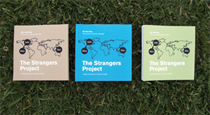|
||
| Introduction / PRELIMINARY RESEARCH / Ideas & Content / The Project: Curious Displays / Project Development / Experiential Prototype / Conclusion |
||

|
||

|
THE STRANGERS PROJECT The Strangers Project is a design intervention dealing with issues of daily ritual and non-traditional communication. The purpose of the project is twofold: one, as a design research technology probe addressing the communicative affordances that emerge from a systematically constrained medium, and two, as an experiment in interaction design, with a new interaction being embedded into an existing behavior instead of a new, learned behavior. The project is based on the amplification of the simple behavior of turning on a lamp in the home. Three existing lamps in three participants’ homes are modified and networked to interface with the lamps in the other participants’ homes. When each participant turns on his or her modified lamp, that action is simultaneously turning on a light in each of the other two participants' homes, as well. In this way, the participant is not asked to learn a new behavior, rather, the project functions within the framework of existing behaviors. The project thus exists as an intervention in the participants' daily behavior, and creates a kind of dissonance in daily behavorial dynamic to gain an understanding of the potential of such a design intervention. The ultimate goal is to have the project gain a sense of invisibility in the daily lives of the participants, and in this way, to gain an understanding of how designing interventions to exist within existing behaviors and frameworks can be a useful way of thinking and making. OUTCOMES A Morse code-style “flicker” became routine when participants came home for the day, or when they just wanted to get one another’s attention. Most interesting and relevant to my larger thesis work, however, was the nuanced and idiosyncratic relationships that were developed by communication through the lights. Participants started seeing the personalities of one another through the behavior of the lights. The individual lights became an embodied representation of the people controlling them on the other side. The lights in this way became anthropomorphized. As a participant myself, I felt that the lights and thus the people behind them were in a sense “trapped." I felt a strong desire to free them from their static position on the wall. |


CURIOUS DISPLAYS. Copyright 2009. Media Design Program, Art Center College of Design. About Julia Tsao. Acknowledgements & Thanks.

